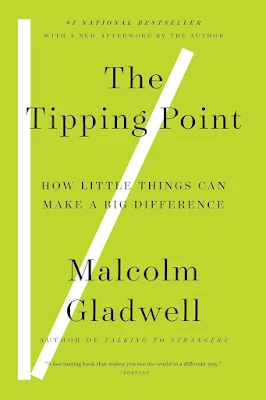Have you ever questioned why certain concepts, items, or habits all of a sudden become extremely popular and spread like wildfire?
These are illustrations of what Malcolm Gladwell, the author of the blockbuster book The Tipping Point: How Small Things Can Make a Big Difference, refers to as "social epidemics." A social epidemic occurs when something that was previously uncommon or unrecognized quickly spreads to become popular and influential.
But how do social epidemics happen? And more importantly, can we start and control them? Gladwell proposes three rules or laws that explain how social epidemics tip: the Law of the Few, the Stickiness Factor, and the Power of Context.
The Law of the Few
Mavens are persons with extensive knowledge and experience in a variety of fields. They love to share fresh information with others and are constantly searching for it. They are not driven by celebrity or wealth, but rather by a sincere desire to aid others in making wiser judgments.
Salesmen are those who excel at convincing others to alter their opinions or behavior. They are endowed with charm, charisma, dynamism, and emotional intelligence. They are able to discern other people's emotions and adjust their message accordingly.
How may you benefit from the Law of the Few? You must first determine who the Connectors, Mavens, and Salesmen are in your network or target market. These are the individuals who, more than anybody else, can assist you in spreading your word or concept widely and quickly.
The Stickiness Factor
How can you benefit from the Stickiness Factor? You must first comprehend what makes your message or concept memorable to your target audience. You must understand what matters to them, what they require, what they desire, what they fear, and what they hope for. You must be aware of their thoughts, feelings, and actions.
The Power of Context
The third principle of social epidemics is that they are affected by the setting or circumstance in which they take place. Depending on the setting in which a message or concept is delivered or received, it may have one or more various outcomes. Physical, social, psychological, and psychological-social elements, including the time, place, weather, and setting, as well as group size, norms, roles, and connections, can all be part of the context.According to The Power of Context, even minor environmental modifications can have a significant impact on how individuals act and think. Gladwell, for instance, uses the "Broken Windows Theory," which contends that lowering less serious signals of disorder and vandalism, such as broken windows or graffiti, might result in a decrease in more serious crimes, like robbery or murder.
How can you make the most of the Power of Context? You must first evaluate the environment in which you wish to share your message or concept. You must decide whether elements will help or impede your social epidemic.
Conclusion
The Tipping Point is a fascinating book that reveals how social epidemics happen and how we can start and control them. By applying the three rules of social epidemics - the Law of the Few, the Stickiness Factor, and the Power of Context - we can increase our chances of creating positive changes in our personal or professional lives.FAQ
The central concept of "The Tipping Point" is the idea of a social epidemic, where ideas, products, messages, and behaviors spread like viruses. They grow gradually until they reach a critical mass, known as the "tipping point," and then explode.
Gladwell introduces three rules of tipping points: The Law of the Few, the Stickiness Factor, and the Power of Context. The Law of the Few refers to the unique charismatic individuals who are crucial for spreading social epidemics.
The Stickiness Factor is the degree to which the content or message of social epidemics is compelling or addictive. The Power of Context centers on the influence of people's environment on their actions and on the outcomes of social epidemics.
Gladwell categorizes the "Few" into Connectors, Mavens, and Salesmen. Connectors love to expand their roster of acquaintances and have the gift of bringing people of different backgrounds together.
Mavens have insider knowledge and selflessly share information with others. Salesmen can convince people of anything and have an answer for every objection.
The "Stickiness Factor" refers to the degree to which the content or message of social epidemics is compelling or addictive. It's the quality that makes an idea, concept, or product memorable and resonates with its audience.
The "Power of Context" centers the influence of people's environment on their actions and on the outcomes of social epidemics. It suggests that human behavior is sensitive to and strongly influenced by its environment.

